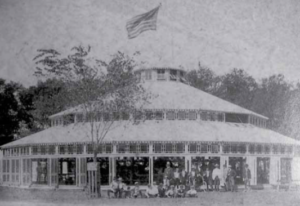 Savin Rock Carousel III
Savin Rock Carousel III
Murphy’s Hippodrome took on rival Wilcox’s by building what became known as Murphy’s Pier. That pier ran behind the Hippodrome on Beach Street and featured ferry service to Lighthouse Point every 5 minutes—or so said the advertisements. Faced with losing business to the Murphys, Fred Wilcox built and even longer pier and put an ice cream parlor at its end and an observation tower a top Savin Rock. The intense competition among concessionaires was literally changing the nature of Savin Rock itself. By 1910, the Grove, once a quaint park for concert goers, was now teeming with concessionaires and not all the development was wholesome. By one estimate, the Grove had more gin mills per square foot than anywhere else in the state.
Still, that did not prevent the Murphys’ next bold move. They built a free-standing carousel house in a remote section of the Grove, and it proved to be a huge hit. In 1914, the carousel’s operators, August McCloud and Bill Koplitski, were arrested and fined $3 for running the carousel on a Sunday to satisfy the immense crowds. For the Murphys, that was just the cost of doing a brisk business, Blue Laws or not. Like everything else, the Murphys pushed the limits.
Inside their Hippodrome building, any number of Murphy carousels took a spin between 1911 and 1919. From 1907 – 1919, for example, the Murphys built at least a dozen carousels, many destined for places as far away as New Orleans.
One of those carousels that had its inaugural spin at Savin Rock was eventually moved to Lighthouse Point Park in 1916, which was conveniently serviced by a Murphy-owned ferry. Timothy Murphy continued running that carousel until 1928, when he sold it to the City of New Haven for $8,500. The merry-go-round was so popular, the city was able to pay off the tab in less than two years. For comparison’s sake, New Haven recently spent $350,000 restoring that very same carousel – which is now a National landmark.
By 1918, the Murphys had over-extended themselves to the point of collapse at Savin Rock. The start of WWI only hastened the inevitable, and the brothers began liquidating most of their Savin Rock holdings to Joe Guliano.
Bart Murphy moved to Louisiana with his family, while Timothy kept busy trying to juggle all those balls he seemed to keep in perpetual motion in hopes of finally making it big. According to our own Savin Rock historian Harold Hartmann, who met Murphy several times in the 1940s, Timothy had the gift of blarney and the personality to match.
“He was a real wheeler-dealer,” Harold remembers, who continued to own and run a number of concessions and kiddie rides in White City into the 1950s. Don Cameron, grandson of George Cameron, said the Murphys left his grandfather holding the proverbial empty money bag when they left Savin Rock in 1919.
“They offered my grandfather the carousel at Savin Rock, but it wasn’t really worth much back then,” Don says with a tinge of regret in his voice. Today that same carousel would be worth millions.
While they never fully realized their dreams of building another Coney Island in New England, there is no question that the Murphys helped shaped Savin Rock’s history as a nationally renowned amusement park. Some of those changes may have been for the worse. But judging from the smiles, laughter, and fond memories they brought to millions of Savin Rock visitors over the years, the Murphys’ influence on West Haven history was undeniably for the better… if only because of their magnificent flying horses that continue to delight thousands of riders each summer at Lighthouse Point and Lake Compounce.
Guest Historian: Peter J. Malia, author of Visible Saints: The Colonial History of West Haven, available from Barnes & Noble and www.connecicutpress.com.